Here are some plants you see everywhere in San Francisco.
Euryops pectinatus. Hate. I think it comes from the family HomeDepotaceae.
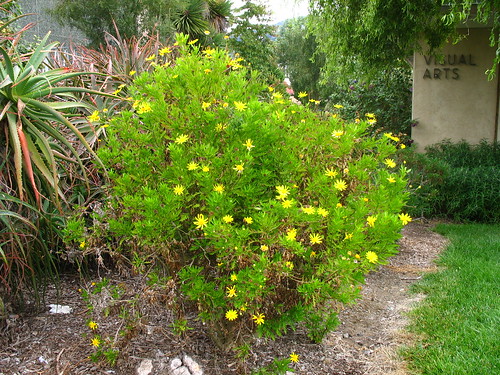
But if I gardened for a living, I would probably use this plant because it always looks good. South African plants do well in San Francisco. People who hire gardeners don't know this plant is boring.
And that aloe around it can be nice too, but it must be maintained. You wouldn't know it, but aloes develop fantastic trunk structure; limb it up and show it off. Plant an understory plant. What would you use?
Raphiolepis indica. Hate, hate, hate. This is the gas station plant par excellence. But what would I rather see at the gas station? Any suggestions? In coastal California, why not use the native Rhamnus californica, aka Coffeeberry, or the hardy cultivar Eve Case? Hell, just plant a manzanita.
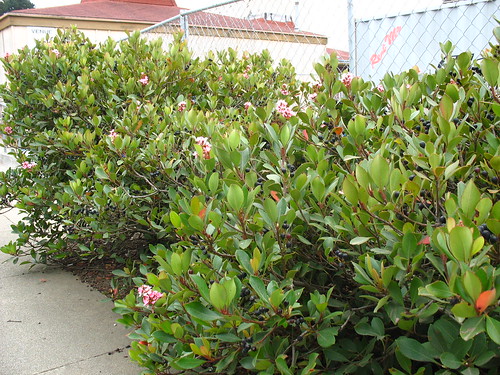
Or even some agave?
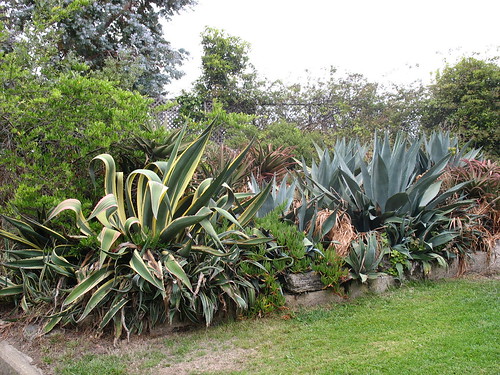
Even the dead flower is interesting.
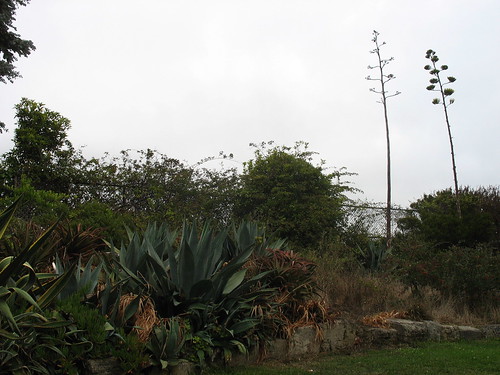
Leptospermum scoparium. New Zealand Tea Tree. I go back and forth on this one. I always like the flowers. But flowerless, it's dark and bristly. In high summer, this plant feels depressing.
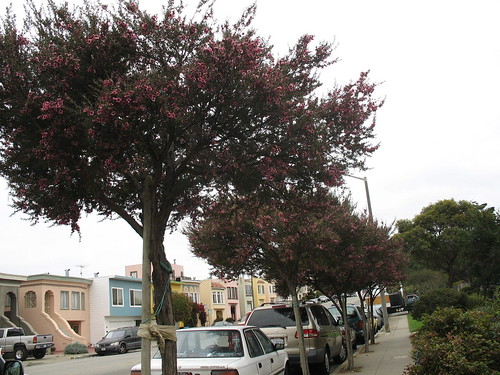
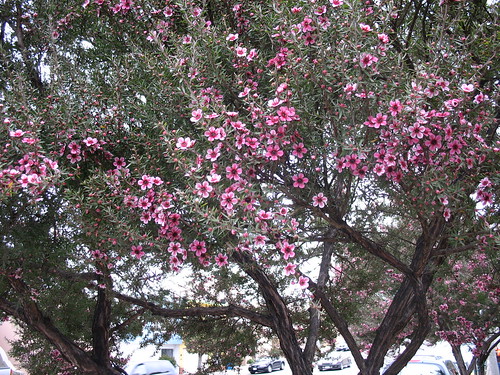
We use it as a street tree which limits its impact. It's a small tree. Wouldn't it look better at the back of the border, juxtaposed with contrasting elements? A nice bright clematis weaving through it could do the trick.
Cotoneaster lacteus. Hate. But don't those berries look nice? We say those folded leaves are "keeled". Keeled leaves are common in the Rosaceae.
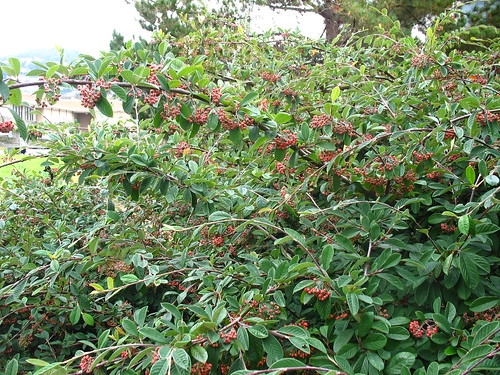
Melaleuca nesophylla. Total indifference.
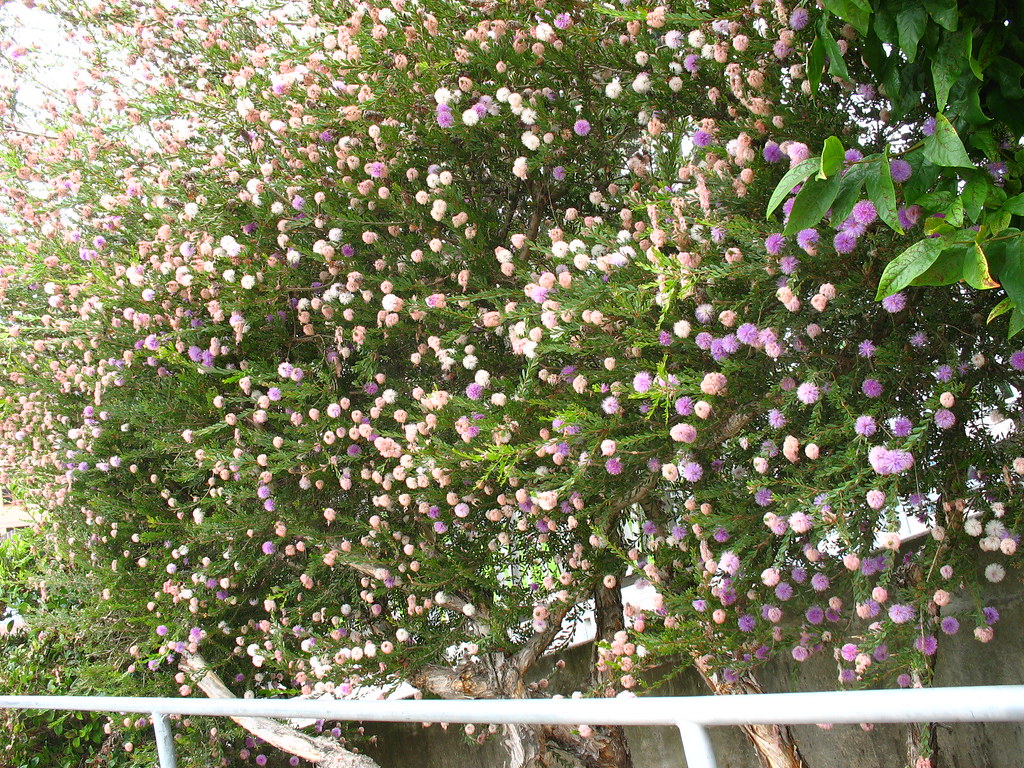
You don't often see it limbed up like this, and that's nice. Melaleucas have exfoliating paperbark--always interesting to see. And those flowers come out when most other flowers have gone and they stay on for a long time. Without the flowers, this plant is hard to notice.
Cistus skanbergii. You can't tell from the pictures, but the flowers are a nice pale pink. I like all the rockroses when in bloom, hate them when not. I have this plant in a container on my deck. I'm thinking about changing it out for something better.
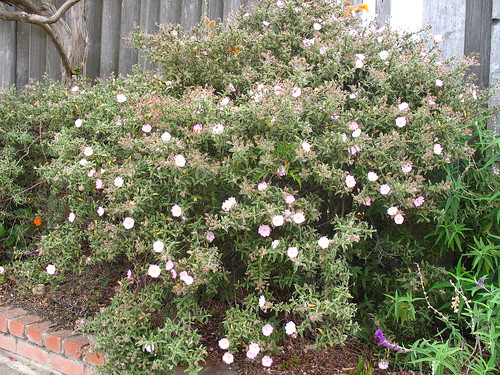
Passiflora mollis. Love.
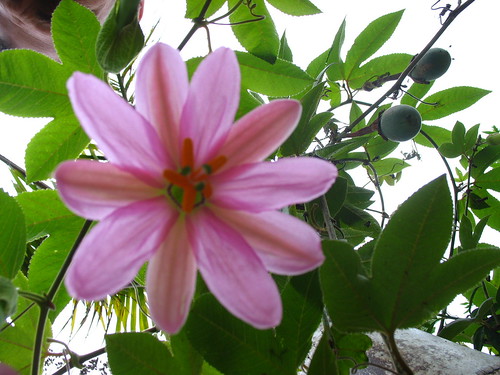
It's an absolute monster, and must be pruned hard every year in the garden. The fruit is not so tasty and may attract rats when it falls. But those cheerful pink flowers... sigh.
What landscape workhorses do you have ambivalent relationships with?

6 comments:
I don't italicize latin botanical names because it is too much trouble and haven't run into very many nomenclature nazis who complained.
Ambivalent I would have to think about. Hate it, Hate it, Hate it is easy.
Areca palm-Chrysalidocarpus lutescens
Hibiscus period.
Bougainvillea, a fine plant for trailer parks. A double pox upon it.
Heliconia psittacorum
Hong Kong Orchid Tree-Bauhinia x blakeana
Often though it is about location, location, location. These can be fine plants in someone else's garden or one that I do not take care of.
We only have two of Christopher's plants around here, Bougainvillea and Hibiscus.
Bougainvillea is extremely common but hibiscus is rare. The others I don't know at all.
I'm not totally down on Bougainvillea, but I have heard exactly that remark about it being suitable for trailer parks.
I've taken to gardening (well, not gardening exactly, more like just planting and looking) only in the last year or so, so my tastes are still developing. And I don't know a lot of the rare stuff yet.
What I will say right now, after two glasses of Chardonnay:
Red hot pokers: Thought I loved then, but then I decided they were gaudy and trashy. Did not plant them.
Blue oat grass: Decided for sure that I loved, planted a ton of them, and now think they're boring. Plus, the gorgeous silvery blue has a lot of tan in October here in Seattle.
Ceanothus: Fell hard for this one in the spring, and just planted a couple of weeks ago. Should I water? It's been very dry, but I hear they hate supplemental watering, but they are just little guys. I've watered every 5 days or so. Every couple of days I look up "ceanothus julia phelps" in google images just to see what I hope to be in for, come spring.
Smoke trees (Royal purple): Love, still love, love, love. Especially behind the oat grass. I love the oval leaves, I love the leggy growth, I love the summer color, I love the fall color. I love everything about them except their deciduosity.
Siberian dogwood: Loving so far. It seems so happy in my planting strip. I don't care if it obscures the view from the street in ways that may not completely adhere to Seattle ordinances. Honestly.
Red dragon (some Latin word that starts with a P, I think): This thing is going crazy, in a good way. I love the arrow-looking leaves and the red stems and the wondrous growth. It is kicking ass over my red curly sedge.
Red curly sedge: Eh.
Orange carax or whatever: I like it, though in September the edges got sort of tan, not nearly as iridescently alive as when I first planted it during the summer.
Euphorbia (two kinds): I would love these, but I wish the yellow jackets would just LAY OFF. Jeez.
Black mondo grass: Was hoping this would take off, but alas, they remain little.
Rosemary: I planted this a couple weeks ago, in an effort to "get real" with the yard. Most of the other stuff I've planted probably would have benefited from some effort I never put in, but any damn fool can grow rosemary. So there it is.
New Zealand flax: It's sort of looking silly, I don't know. I used to love it, but now I feel like I'm trying to put one over on the neighborhood. I don't like the look of an all-native garden (too green), but now I'm thinking that brown and pink variegated may not be the way to go.
Remember that wine I had, OK?
Canna lilies -- Was loving these when they first came up in August or whenever, but now I'm so sick of seeing their '70s garish tall bright totally un-Northwest bad selves, that I sort of want to cut them down. But they seem to like me, and really they are pretty, so what can I do?
Purple barberry -- This was one of my first choices over a year ago, and they've done well, so I kind of feel like they're old friends. They're pretty; I just don't like them in the winter. But they're off to the side, so it's OK.
Miniature pine: Love. Obviously.
Some tall purple-foliage plants that have red flowers and are attacked by slugs, I can't remember the name: The lady at the Fairie Garden, where I bought these, south of Olympia, told me not to get them because the slugs would eat them. But I showed her! I bought them anyway, and they've done great! I love them.
Honeysuckle? Little plants with lime leaves that sort of look like barberry/boxwood: Fine. They're by the street. They have not grown much, which makes me feel like a failure, but I won't resent them for it.
Purple fountain grass: Was perfect for its container all summer. Bye-bye, purple fountain grass!
Miscanthus in planters: Why did you not grow big and tall? I thought you ornamental grasses loved a PNW summer! Are the planters too small for you? Are you too close to the AC that I was hoping you would disguise? Tell me, tell me, and I will half-heartedly try to make it better!
Pampas grass: I know I will probably regret having planted you, but for now you are fine in that soil that I am too lazy to de-rock.
New boring evergreen bush off to the side where the destructive magnolia used to be: Welcome! I am sorry I have forgotten your name, but I hope you enjoy your stay here!
You can give supplemental water to a young Ceanothus once every week or two for the first couple of summers. Give it a deep, thorough soaking and let it dry out between waterings.
After Ceanothus is established, it really depends on the site and soil whether it can handle supplemental irrigation, but in general it's a short-lived plant in heavily watered gardens.
Whatever you do, do not water Ceanothus on hot, sunny days. If you feel you must water it, do so after the sun is off the plant for the day, and really soak it. The sun heats up rich, moist soil and facilitates the growth of the microorganisms that kill it. (The thoroughness of the soaking helps lower the temperature of the soil around the plant so fungus doesn't grow.) Ceanothus and other west-coast natives evolved in nitrogen-poor soil with no water on hot summer days. That's how they like it.
I like that blue oat grass too. Leymus is the genus name. I thought it might be nice to have some in terracotta pots here and there so I can move 'em out of site when I'm not in to it. Plus, I understand it really spreads and I'd like to keep it manageable.
Thanks for coming by, and thank you for drinking!
My pleasure, on both counts!
Thanks for the advice on the Ceanothus. I'm hoping it makes it longer than the four or five years that I just found out that the authors of "Ceanothus" give that particular cultivar to live.
And thank you for all the great photos, especially the ones of people's yards. Does someone have a site that's just photos of people's yards, like someone has a site that's just photos of weirdly dressed people on the streets of Helsinki (http://www.hel-looks.com/)?
Also, I think my blue oat grass is not Leymus, but the ultra-common-in-Seattle Helictotrichon.
I forgot to mention that I love my new beautyberry plant, and I also like my Salvia, which seems to be surviving all the attention it's getting from the neighborhood dogs.
Just bumbled onto your blog.
You seen to know your stuff.
I haven't gardened since I left Seattle 10 years ago. Now I have a space at my new home and need to plan and plant. I need a couple of small trees and would really love to use one of the smaller dogwoods. I have not seen any in SF. Do they do well here or is it like the lilac that a few people try to make live here. I always want to put them down quietly, with dignity.
Post a Comment